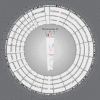Gamma Knife Radiosurgery does not alter the copy number aberration profile in sporadic vestibular schwannoma
- PMID: 32980934
- PMCID: PMC7609431
- DOI: 10.1007/s11060-020-03631-4
Gamma Knife Radiosurgery does not alter the copy number aberration profile in sporadic vestibular schwannoma
Abstract
Introduction: Ionizing radiation is a known etiologic factor in tumorigenesis and its role in inducing malignancy in the treatment of vestibular schwannoma has been debated. The purpose of this study was to identify a copy number aberration (CNA) profile or specific CNAs associated with radiation exposure which could either implicate an increased risk of malignancy or elucidate a mechanism of treatment resistance.
Methods: 55 sporadic VS, including 18 treated with Gamma Knife Radiosurgery (GKRS), were subjected to DNA whole-genome microarray and/or whole-exome sequencing. CNAs were called and statistical tests were performed to identify any association with radiation exposure. Hierarchical clustering was used to identify CNA profiles associated with radiation exposure.
Results: A median of 7 (0-58) CNAs were identified across the 55 VS. Chromosome 22 aberration was the only recurrent event. A median aberrant cell fraction of 0.59 (0.25-0.94) was observed, indicating several genetic clones in VS. No CNA or CNA profile was associated with GKRS.
Conclusion: GKRS is not associated with an increase in CNAs or alteration of the CNA profile in VS, lending support to its low risk. This also implies that there is no major issue with GKRS treatment failure being due to CNAs. In agreement with previous studies, chromosome 22 aberration is the only recurrent CNA. VS consist of several genetic clones, addressing the need for further studies on the composition of cells in this tumor.
Keywords: Gamma Knife Radiosurgery; Genetics; Intratumor genetic heterogeneity; Neurosurgery; Vestibular schwannoma; Whole genome microarray.
Figures



Similar articles
-
Genetic landscape of sporadic vestibular schwannoma.J Neurosurg. 2018 Mar;128(3):911-922. doi: 10.3171/2016.10.JNS161384. Epub 2017 Apr 14. J Neurosurg. 2018. PMID: 28409725
-
Gamma Knife radiosurgery for treatment of growing vestibular schwannomas in patients with neurofibromatosis Type 2: a matched cohort study with sporadic vestibular schwannomas.J Neurosurg. 2018 Jan;128(1):49-59. doi: 10.3171/2016.9.JNS161463. Epub 2017 Jan 27. J Neurosurg. 2018. PMID: 28128697
-
Gamma Knife radiosurgery for vestibular schwannoma: clinical results at long-term follow-up in a series of 379 patients.J Neurosurg. 2014 Dec;121 Suppl:123-42. doi: 10.3171/2014.8.GKS141506. J Neurosurg. 2014. PMID: 25434946
-
Gamma knife radiosurgery for vestibular schwannoma.Otolaryngol Clin North Am. 2009 Aug;42(4):635-54. doi: 10.1016/j.otc.2009.04.009. Otolaryngol Clin North Am. 2009. PMID: 19751869 Review.
-
Retreatment of vestibular schwannoma with Gamma Knife radiosurgery: clinical outcome, tumor control, and review of literature.J Neurosurg. 2018 Jul;129(1):137-145. doi: 10.3171/2017.3.JNS162033. Epub 2017 Oct 6. J Neurosurg. 2018. PMID: 28984523 Review.
Cited by
-
Genetic alterations associated with malignant transformation of sporadic vestibular schwannoma.Acta Neurochir (Wien). 2022 Feb;164(2):343-352. doi: 10.1007/s00701-021-05062-0. Epub 2021 Nov 24. Acta Neurochir (Wien). 2022. PMID: 34816314 Free PMC article.
References
MeSH terms
LinkOut - more resources
Full Text Sources
Medical

